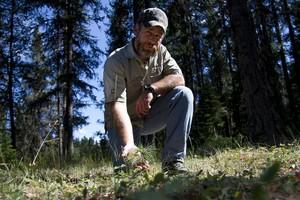Climate threatsEnvironmental “secondary perils” an increasing threat: Swiss Re
The catastrophe loss experience of the last two years is a wake-up call for the insurance industry, highlighting a trend of growing devastation wreaked by so-called ‘secondary perils’ – which are independent small to mid-sized events, or secondary effects of a primary disaster.

Examining impact on SERE training // Source: af.mil
Insured losses from natural catastrophes in 2018 were $76 billion, the fourth highest one-year total, according to the latest sigma report from the Swiss Re Institute, and more than 60 percent of the losses resulted from secondary perils. The insured losses from natural catastrophes in 2017 and 2018 together were $219 billion, the highest ever for a two-year period. In 2017, when aggregate natural disaster insurance claims were the highest ever in a single year, more than half were due to secondary perils. Losses from secondary perils are rising due to urbanization, rising concentration of assets in areas exposed to extreme weather conditions, and climate change.
The Swiss Re Institute report says that the risks posed by secondary perils tend to be underestimated because their impact is masked by the losses inflicted by primary events, as was the case in 2017 with Hurricanes Harvey, Irma and Maria. However, their growing loss potential is becoming ever more apparent.
“Large losses from secondary perils are occurring more regularly”, says Edouard Schmid, Swiss Re’s Group Chief Underwriting Officer. “This is a trend the insurance industry must act on so that we can continue to underwrite catastrophe business sustainably.”
Swiss Re says that the combined insurance losses for 2017 and 2018 were USD 219 billion, the highest-ever for a two-year period, with more than half due to secondary perils. There were no mega-loss generating events in 2018. Of last year’s losses, 62 percent were due to secondary perils. The potential force of secondary perils is further supported by the peak loss experience of 2017, when Hurricanes Harvey, Irma and Maria took the insured loss total for the year to the highest ever. Even with these mega-loss events, more than half of the annual losses were due to less well-monitored secondary perils.
The combined global natural catastrophe protection gap of 2017 and 2018 was $280 billion, and more than half of that resulted from secondary perils. Explanations for underinsurance include lack of consumer risk awareness, a poor understanding of the catastrophe cover available, and hesitation on the side of the industry to provide cover where risk assessment is uncertain. Assessing secondary peril risks can be difficult given their unique features. For example, secondary perils are often highly localized, but with variables that are in a continual state of flux given land-use changes and greater occurrence of extreme weather.
“The existing protection gap is an opportunity for insurers to strengthen global resilience,” Jérôme Jean Haegeli, Swiss Re’s Group Chief Economist, says. “Underwriting catastrophe business profitably means looking at peak and also forward-looking trends on secondary perils. By leveraging latest technology, insurers can focus more on developing appropriately regionalized models to assess the risk posed by secondary perils and develop a greater product range and targeted distribution for catastrophe covers.”
Re/insurers can also build socio-economic resilience through their investment activities, in particular by being able to invest more in sustainable infrastructure projects. There are many examples of disaster mitigating defenses having been strengthened as part of reconstruction efforts after a catastrophic event. With a more conducive investment and regulatory environment, insurers can play a much more effective ex-ante role. According to Swiss Re Institute estimates, global re/insurance assets amount to approximately $30 trillion. Even a small part of this could unlock a significant amount of capital for deployment into long-term resilience-building infrastructure projects.
— Read more in Lucia Bevere, sigma 2/2019: Secondary natural catastrophe risks on the front line (Swiss Re Institute, April 2019)
